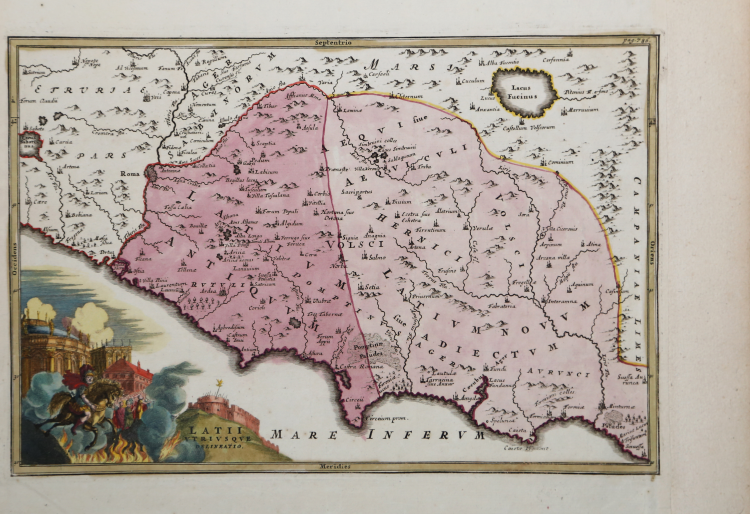



| Reference: | S29355 |
| Author | Christoph CELLARIUS |
| Year: | 1701 ca. |
| Zone: | Latium |
| Printed: | Amsterdam |
| Measures: | 310 x 210 mm |


| Reference: | S29355 |
| Author | Christoph CELLARIUS |
| Year: | 1701 ca. |
| Zone: | Latium |
| Printed: | Amsterdam |
| Measures: | 310 x 210 mm |
This 'ancient geography' map shows Rome and the west side of Italy.
Original copperplate-engraved map on hand-made paper, published for the 1732 edition of Geographia Antiqua (Antique Geography) by German Scholar Christopher Keller (known as Cellarius) (1632-1707). First published by Cellarius in 1686, this work was reissued many times, until 1812. The 1732 edition was larger and more attractively presented. Many of the maps had decorative cartouche title pieces. This wonderful cartouche shows grand buildings of Rome, fire and smoke, and the army on horseback.
In good condition, this map would have been published in black and white. It has fine later hand-tinting with watercolour, that certainly adds to the attractiveness of the map.
|
Christoph Cellarius (1638 - 1707) or, more commonly, Christopher Keller was a German scholar, historian and textbook publisher working in the later part of the 17th century. Cellarius is known to have been born in Schmalkalden and to have held academic positions in both Weimar and Halle. C. Cellarius's most important contribution was his 1683 publication of A Universal History Divided into an Ancient, Medieval, and New Period. It was in this work that the concept of history as divisible into three distinct periods (Ancient History, Mediaeval History, and Modern History) was introduced. Likely Cellarius never understood the impact that his structured system of historical nomenclature would have on the way future historians would interpret the past. Christopher Cellarius should not be confused with the more widely known cosmographer Andreas Cellarius
|
|
Christoph Cellarius (1638 - 1707) or, more commonly, Christopher Keller was a German scholar, historian and textbook publisher working in the later part of the 17th century. Cellarius is known to have been born in Schmalkalden and to have held academic positions in both Weimar and Halle. C. Cellarius's most important contribution was his 1683 publication of A Universal History Divided into an Ancient, Medieval, and New Period. It was in this work that the concept of history as divisible into three distinct periods (Ancient History, Mediaeval History, and Modern History) was introduced. Likely Cellarius never understood the impact that his structured system of historical nomenclature would have on the way future historians would interpret the past. Christopher Cellarius should not be confused with the more widely known cosmographer Andreas Cellarius
|